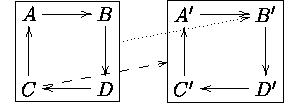t.s | merge t with simple s |
{t} | make t simple |
The first will enlarge t to also "cover" the "simple" s
(simple means that it cannot have changes etc. attached unless
encapsulated in {}s). Here is an example where we merge and
frame:
\xymatrix @R=1pc {
1,1 & 1,2 & 1,3 & 1,4 & 1,5 \\
2,1 & 2,2 & 2,3 & 2,4 & 2,5
\save "1,2"."2,4"*[F.]\frm{}
\ar"1,1" \ar"2,1" \ar"1,5" \ar"2,5"
\restore }
As you can see, the center of the merged object is the same as the
one of the target before the ".."
Finally a more advanced example where we create two merged objects
with center in their "real" center, name them and then connect
to them. It also shows how macros can be used inside diagrams: they
should always expand to "commands" like \ar..., etc.:

can be typeset by
\def\g#1{\save
[].[dr]!C="g#1"*[F]\frm{}\restore}%
\xymatrix{
\g1 A\ar[r]&B\ar[d]&\g2 A'\ar[r]&B'\ar[d]\\
C\ar[u]&D\ar[l]& C'\ar[u]&D'\ar[l]
\ar @{.>} "g1" ;"1,4"
\ar @{-->} "2,1";"g2" }"g1" and "g2" as shown.